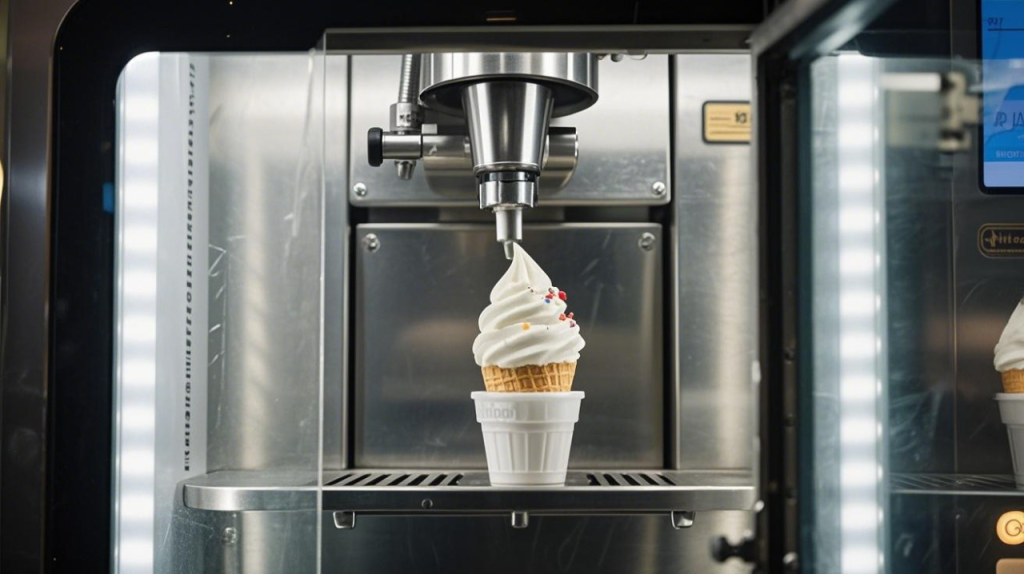
Ice cream makers are fascinating machines that transform simple ingredients into a beloved frozen treat. Whether in a home kitchen or a commercial vending machine, the core principles of ice cream production remain the same. This post explores the mechanics behind ice cream makers, focusing on the technology that drives automatic.
Ice cream is a blend of milk, cream, sugar, and flavorings. When frozen, these ingredients form a smooth, creamy texture. Achieving this consistency requires two critical processes: freezing and aeration.
Freezing solidifies the mixture, but if done too quickly or unevenly, it creates large ice crystals, resulting in a gritty texture. Aeration, or incorporating air into the mix, gives ice cream its lightness. Commercial machines carefully balance these steps to ensure quality.
Modern ice cream makers, especially automated vending systems, rely on several integrated components:
Core Components & Functions
| Component | Function |
|---|---|
| Ingredient Storage Tanks | Store pre-mixed bases, flavors, and toppings under refrigeration. |
| Mixing Chamber | Combines ingredients and homogenizes the mixture. |
| Refrigeration System | Rapidly cools ingredients to -15°C to -20°C using compressors. |
| Dasher (Paddle) | Churns mixture, scrapes chamber walls, and incorporates air. |
| Dispensing Mechanism | Extrudes ice cream into cups/cones with precise portion control. |
| Control Panel & Software | Manages user input, payment, and coordinates machine operations. |
Pre-mixed liquid bases are pasteurized and homogenized offsite. These are loaded into the machine’s sanitized tanks. Flavors and additives are added during the mixing phase.
When an order is placed, the machine pumps the base into the freezing chamber. The refrigeration system activates, and the dasher rotates simultaneously. As the mixture freezes, the paddle scrapes ice crystals off the walls, blending them into the cream. This continuous churning creates a smooth consistency.
The dasher’s rotation introduces air into the mix. Commercial machines control overrun (typically 30–50%) precisely, ensuring each batch meets quality standards.

After 5–15 minutes (depending on batch size), the ice cream reaches the desired texture. A piston or auger pushes it through the dispensing nozzle. Toppings are added automatically if selected.
Many commercial machines have automated cleaning cycles. Steam, hot water, or food-safe sanitizers flush the system to prevent cross-contamination.
| Feature | Commercial Makers | Home Makers |
|---|---|---|
| Refrigeration | Heavy-duty compressors (-15°C to -20°C) | Pre-frozen bowls or weak compressors |
| Batch Size | Single servings on demand | 1–2 quarts per batch |
| Automation | Integrated payment, customization, cleaning | Manual operation |
| Speed | 5–15 minutes per serving | 20–40 minutes per batch |
| Cost | High upfront cost, built for scalability | Affordable, for personal use |
| Challenge | Solution |
|---|---|
| Temperature fluctuations | Durable compressors and real-time thermal sensors. |
| Ingredient spoilage | Sealed, refrigerated storage tanks. |
| Mechanical wear | Stainless steel parts and automated diagnostics. |
Understanding how does an ice cream machine work is key to appreciating the technology behind today’s automated dessert experience. These machines operate by combining precise freezing, controlled aeration, and hygienic dispensing to turn liquid mix into smooth, ready-to-eat soft serve.
In modern vending formats, this process is fully automated—ensuring consistency, speed, and minimal human contact. By making premium frozen desserts accessible at any time and location, ice cream machines offer a practical, efficient solution for businesses and consumers alike.
Notification